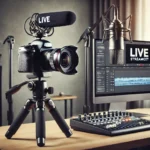Introduction
In the world of live streaming, choosing the right camera is one of the most critical decisions you can make. The camera you use has a significant impact on your video quality, viewer experience, and overall success in engaging your audience. Whether you’re streaming on platforms like YouTube, Twitch, or Facebook Live, investing in the best camera tailored to your specific requirements is key. But with so many options available, ranging from budget webcams to professional DSLRs, knowing where to start can be challenging. This guide will help you navigate the decision-making process and identify the perfect camera for your live streaming needs.
Understand Your Live Streaming Needs
The first step in choosing the best live-streaming camera is to assess your specific needs. Ask yourself these questions:
- What type of content will you stream? Gaming, cooking tutorials, fitness sessions, or interviews may require different camera setups.
- What resolution and video quality do you need? Platforms typically support different resolutions—1080p Full HD or even 4K UHD might be desirable but not always necessary.
- Will you be streaming indoors or outdoors? Lighting conditions significantly affect camera performance, so choose accordingly.
- What is your budget? Cameras fall into various price ranges, from economical to premium options.
Clearly identifying your priorities will help narrow down choices and focus on the features most important for your content creation.
Key Features to Look For in a Live Streaming Camera
When selecting a camera for live streaming, prioritize the following features:
1. Resolution and Frame Rate
Resolution determines the clarity of your video, while frame rate affects how smooth the video looks. For most streams, 1080p at 30fps is sufficient. However, if you want the best quality or anticipate needing 4K streaming in the future, you may want to invest in a higher-resolution camera.
2. Low-Light Performance
Lighting is rarely perfect during live streams, so it’s essential to have a camera that performs well in low-light situations. Cameras with larger sensors typically capture more light, resulting in better image quality even in dim scenarios.
3. Autofocus and Zoom
Fast and accurate autofocus is crucial when moving around or changing positions during a stream. For those who need close-ups or wide-angle shots, optical zoom is an added advantage.
4. Audio Input
While external microphones provide better sound quality, having a camera with built-in audio input can make setup easier for beginners. Look for a 3.5mm jack or an HDMI port that supports audio.
5. Connectivity Options
Reliable live streaming requires robust connectivity. Ensure the camera supports HDMI output, USB connectivity, or Wi-Fi streaming, depending on your setup. Compatibility with popular streaming software like OBS or vMix is also a plus.
6. Portability and Durability
If you’ll be streaming on the go, prioritize lightweight and compact models. Durability is equally important, especially for outdoor streamers who may expose their equipment to varying environmental conditions.
Types of Cameras for Live Streaming
There are several types of cameras to choose from, depending on your needs and budget:
1. Webcams
- Best For: Beginners and budget-friendly setups.
- Pros: Affordable, easy to set up, and typically compatible with most computers.
- Cons: Limited image quality compared to DSLRs and mirrorless cameras.
Popular options: Logitech C920, Razer Kiyo, Elgato Facecam.
2. DSLR Cameras
- Best For: Professional streamers and those seeking cinematic video quality.
- Pros: Superior image quality, interchangeable lenses, great low-light performance.
- Cons: Expensive and may require additional accessories like a capture card.
Popular options: Canon EOS Rebel T7, Nikon D5600.
3. Mirrorless Cameras
- Best For: High-quality video with portability.
- Pros: Lightweight, excellent video quality, and advanced features.
- Cons: Pricier than webcams and may need additional components for streaming.
Popular options: Sony a6400, Panasonic Lumix GH5.
4. Action Cameras
- Best For: Outdoor and on-the-move streams.
- Pros: Compact, rugged, good for dynamic environments.
- Cons: Limited by small sensors and can lack advanced settings.
Popular options: GoPro HERO11, DJI Osmo Action.
Tips for Choosing the Best Camera on a Budget
If you’re just starting, don’t feel pressured to break the bank. Here are some budget-friendly tips:
- Start with a webcam: Affordable and easy to install, webcams are great for beginners.
- Check for refurbished models: Trusted refurbished cameras from reputable brands can save money.
- Use your smartphone: Modern smartphones often have excellent video capabilities and can serve as a budget-friendly option with the right apps.
- Prioritize core features: Invest in the minimum set of features you need. You can always upgrade as your channel grows.
Accessories to Consider
Your camera is only part of the equation. To optimize your live streaming quality, consider these essential accessories:
- Lighting: Ring lights or LED panels to improve video quality.
- Microphone: External mics for better audio clarity.
- Capture Card: Required for streaming with DSLRs or mirrorless cameras.
- Tripod or Mount: For stable and professional shots.
Final Thoughts
Finding the best camera for live streaming requires evaluating your content goals, budget, and environment. Whether you’re a beginner sticking to a simple webcam or a professional seeking DSLR-level video quality, there are plenty of options available to suit your needs. Take time to research, test out features, and consider long-term goals to ensure your investment serves you well in the ever-evolving world of live streaming. Armed with the right camera, you’re well on your way to creating engaging, high-quality streams that captivate your audience and keep them coming back for more.
